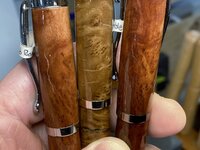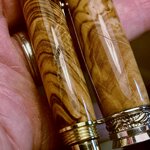Todd in PA
Member
I thought I'd ask, and answer, which woods have you given up on?
In my limited experience, these woods will come off the lathe looking beautiful, but will not hold up after a few months. It may be my home, or Pennsylvania humidity. But these woods have topped my No Fly List.
Please tell me if there are any species that you've given up on. Or disagree with my list. Maybe what I got wasn't dried properly? Maybe my shop where I store the wood is too humid? Or too cool? Am I in left field? Or are these woods problematic?
I have an AirThings in my shop which tracks temperature and humidity. These are my reports.



In my limited experience, these woods will come off the lathe looking beautiful, but will not hold up after a few months. It may be my home, or Pennsylvania humidity. But these woods have topped my No Fly List.
- Olive Wood
- Eucalyptuses (Red Box Burl, Brown Box Burl, Bimble Box Burl)
- Ebony
- Close but not quite on my list is Ironwood.
- I've heard bad things about snake wood. (enough that I've never tried it).
Please tell me if there are any species that you've given up on. Or disagree with my list. Maybe what I got wasn't dried properly? Maybe my shop where I store the wood is too humid? Or too cool? Am I in left field? Or are these woods problematic?
I have an AirThings in my shop which tracks temperature and humidity. These are my reports.


